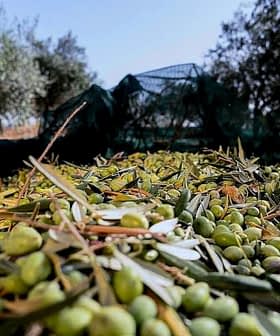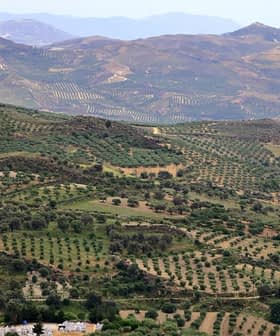Producers in Greece Generate Electricity with Olive Mill Wastewater

Anaerobic digestion technology is now being used in Greece to manage olive mill wastewater, following the success of biogas production from livestock waste. While there are challenges in terms of the low quantities of olive mill wastewater currently being processed, experts believe that there are promising prospects for applying this technology in Greece, similar to what has been done in Italy. The technology not only helps in managing toxic residues but also contributes to green energy production and the circular economy.
Following the production of biogas from livestock waste, anaerobic digestion technology is now emerging as a solution for managing olive mill wastewater in Greece.
With the first biogas plants now processing liquid waste produced through olive oil extraction, a small group of olive oil producers in northern Greece can rid themselves of the responsibility of disposing of the toxic material while contributing to the production of green energy.
However, there are still some challenges involved. The quantities of olive mill wastewater currently feeding biogas plants are extremely low in relation to the total amount produced across the country.
However, experts point to Italy, suggesting there are similar prospects for applying the technology to those of their neighbor.
No need for evaporation tanks
For the Kyklopas SA olive mill, in Evros, in northeastern Greece, the disposal of olive mill waste for biogas production is a welcome solution in the management of the toxic residues.
“Our cooperation with the production unit of Biogas Komotini SA has taken a burden off our backs,” Niki Kelidou, of Kyklopas SA, said. “Despite the fact that we have a license to dispose of the residue in our unit, the management of wastewater is a job that requires significant effort and costs as the quantities we produce are high.”
The family-owned olive mill produces 3.4 million liters of liquid wastewater annually as a byproduct of its annual production of 260 tons of olive oil.
See Also:Biomass from Olive Groves Fuels Heineken Factory in Southern Spain“The cost of building the reservoir where the liquid waste was deposited for evaporation was €40,000 and we built it just two years before we started collaborating with the biogas plant,” Kelidou said. “Had we struck the deal earlier, we would not have built the tank.”
In addition to construction costs, the maintenance of the discharge basin incurs additional expenses.
“Every two to three years, the tank must be emptied and the thick sludge has to be scraped,” Kelidou said. “Moreover, we incurred transport costs because the tank is located at a distance of 20 kilometers from the olive mill.”
An additional factor that enabled the cooperation with the biogas plant is the short distance that separates them, which keeps transportation costs relatively low.
“The Komotini biogas plant is only 50 kilometers from the mill,” Kelidou said. “This is crucial because, during the operation of the mill, about five tanks are loaded on a daily basis and transported to the biogas plant.”
A great environmental hazard
The problem of olive mill wastewater management is acute as the quantities produced amount to several hundred thousand tons.
In fact, the problem concerns all olive oil-producing regions in the Mediterranean. The annual production of olive mill wastewater across the basin is estimated to exceed 30 million cubic meters, of which 50 percent consists of liquid waste.
More than half of this amount is channeled into streams, which usually end up in groundwater. The pollution caused in groundwater by phenols creates toxicity problems, while the contamination of surface waters is also high.
The remaining volumes of the olive mill liquid waste are channeled to the ground (20 percent) and the sea and rivers (12 percent). Only 10 percent are directed to evaporation tanks and other infrastructure which is appropriate for the disposal of this toxic liquid.
Green energy from olive oil waste
Thessaloniki-based Biogas Lagada SA, which has been in operation since 2015, receives approximately 4,000 tons of olive mill liquid waste annually. This corresponds to five percent of the total waste received by the unit.
“We receive 80,000 tons of waste annually, which consists mainly of livestock waste matter, producing 8,400 MWh of electricity,” said Odysseas Koupatsiaris, the director of Biogas Lagadas SA. The production of the unit covers the electricity needs of about 1,500 households.
See Also:Olive Oil Waste Fuels Spanish Power Plant and Palestinian StartupUtilizing the mill’s waste can also contribute towards the circular economy in addition to green energy production.
“At the Lagada biogas plant, we also produce 75,000 tons of organic fertilizer, which is supplied to growers at a competitive cost of €2.00 to €2.50 per ton and is mainly applied to wheat or cornfields,” Koupatsiaris said.
A small-scale solution
However, there are significant limitations and the disposal of olive mill waste for biogas production cannot be a large-scale solution.
“One difficulty concerns the seasonal flow of raw material during the period of olive oil production, which only stretches across a few months a year,” Koupatsiaris said. “The waste could potentially be stored in the premises of the biogas unit to feed supply through the year, but this means that appropriate storage should have been planned during the design of the biogas plant facilities, which is not the case.”
Additionally, olive mill waste cannot account for the total amount of waste. It must be combined with large volumes of other types of waste, such as manure, to be digestible.
“I estimate that olive mill waste cannot be more than 30 percent of the materials processed in the unit,” Koupatsiaris said. “This is because some of the waste components create a problem and can disrupt the chemical process of biogas production.”
“Thus, to correct the problem created by the levels of carbon and fats, it is mixed with waste from pig farms, poultry farms and mink units, as this creates the necessary balance of carbon to nitrogen,” he added.
Positive prospects
However, the limitations facing the disposal of olive mill liquid waste do not cancel the fact that the technology has promising prospects, experts say.
“In Greece, the liquid waste of olive mills is considered as a secondary source of biomass, but in Italy, there are biogas units that are designed to run on olive mill waste exclusively and belong to companies in the olive oil sector,” said Costas Alexandridis, member of the Board of the Hellenic Association of Biogas Producers.
“The technology is not well known in Greece, which perhaps explains the low levels of its application,” he added.









